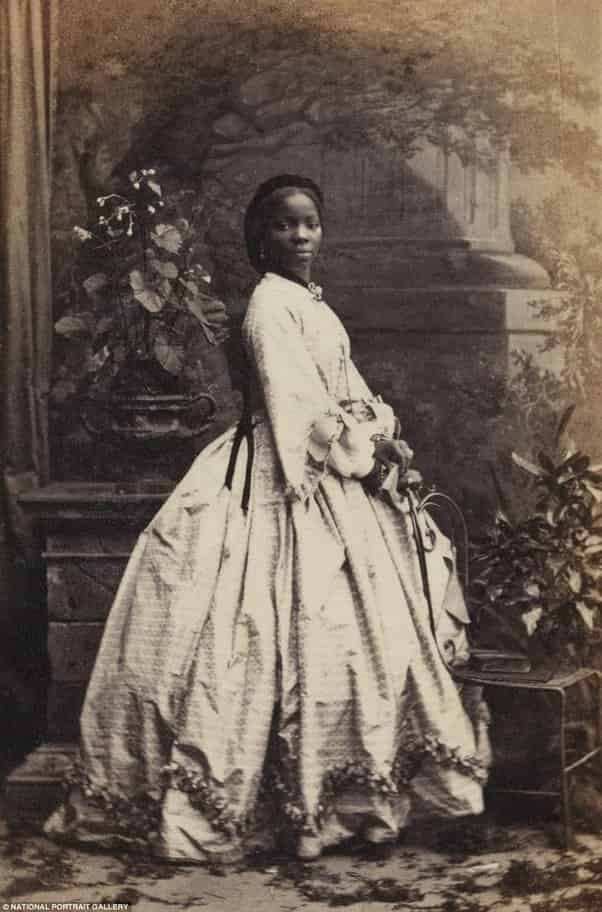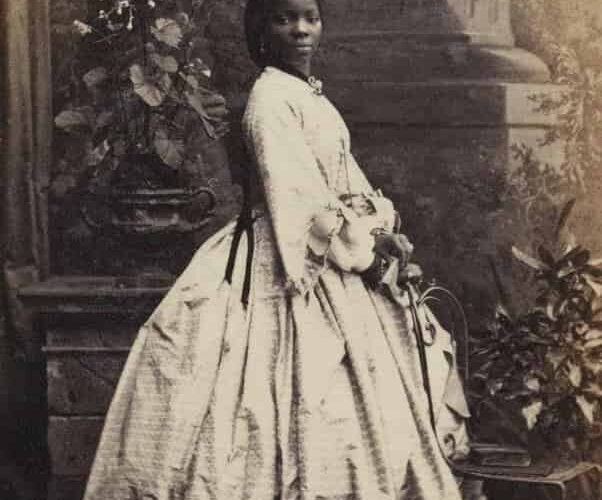From Enslavement to Royal Court: The Incredible Story of Sara Forbes Bonetta

Some stories from history are so extraordinary that they feel almost impossible to believe. One such story is that of Sara Forbes Bonetta. She was once an enslaved child, held captive in the court of a powerful and infamous king in West Africa. In 1850, her life changed forever when she was given as a “gift” to a British naval officer, who brought her to England for Queen Victoria.
The Queen ensured Sara was cared for and educated, eventually arranging her marriage. Sara later became the mother of Victoria Davies, who was Queen Victoria’s goddaughter. Sara’s story is so remarkable that even her descendants once doubted its truth, thinking it was an exaggerated family legend.
Captivity and Rescue
In May 1850, Captain Frederick Forbes of the British Navy visited the court of King Ghezo of Dahomey (modern-day Benin). His mission was to convince the king to stop trading enslaved people. This was not the first attempt; previous efforts had failed, and Britain had only recently turned against the slave trade themselves. Captain Forbes carried letters from Queen Victoria expressing her opposition to the practice. Along with the letters, the Queen sent luxurious gifts, including silk and fine cloth, hoping to persuade King Ghezo.
King Ghezo, however, refused to stop trading enslaved people, pointing out that the British had once participated in it as well. As was customary, the King gave Captain Forbes gifts to take back to Queen Victoria. These gifts included fine cloth, cowrie shells (used as currency in West Africa), a barrel of rum, and something unexpected: a young enslaved girl.
The girl, about seven or eight years old, had been captured two years earlier during a conflict where her parents were killed. Forbes named her Sara Forbes Bonetta after himself and his ship, HMS Bonetta. The sailors on the ship affectionately called her “Sally.”
Arrival in Britain and Meeting the Queen
When the ship returned to Britain, Captain Forbes contacted Queen Victoria, who agreed to support Sara’s education and care. She also expressed a desire to meet the child. On November 9, 1850, Sara met the Queen at Windsor Castle for the first time.
Queen Victoria wrote in her diary about the encounter:
“We came home and found Captain Forbes and a poor little negro girl whom he brought back from the King of Dahomey. Her parents and all her relatives had been sacrificed. Captain Forbes saved her life by asking for her as a present… She is 7 years old, sharp and intelligent, and speaks English. She was dressed as any other girl.”
The Queen took a personal interest in Sara’s life, integrating her into the extended royal circle and ensuring she received a quality education.
Life in Sierra Leone and Return to England
In Victorian Britain, many people believed that the cold climate was harmful to Black people’s health. Concerned for Sara’s well-being, the Queen arranged for her to live in Sierra Leone, a British colony in West Africa, in 1851. Sara stayed there for several years before returning to England.
By December 1855, Sara had grown into a young woman. Queen Victoria noted her progress in her diary:
“Saw Sally Forbes, the negro girl whom I have had educated. She is immensely grown and has a nice slim figure.”
Marriage and Family
In 1862, Sara was living in Brighton under the care of Miss Sophia Welsh. Around this time, she met James Pinson Labulo Davies, a successful West African businessman from Sierra Leone. James had known Sara as a child in Sierra Leone and now expressed interest in marrying her. Though Sara, only 19 at the time, was not eager about the idea, Queen Victoria approved of the match.
In August 1862, Sara married James in a grand wedding. She signed her marriage certificate as “Sara,” but also included her African birth name, “Ina.” The wedding was a major event, with crowds gathering in the streets of Brighton to celebrate. Newspapers across Britain and the British Empire reported on the lavish ceremony.
Shortly after their wedding, the couple visited Camille Silvy’s famous photographic studio to have their portraits taken. These images show Sara and James dressed elegantly, posing as members of high Victorian society.
A Life Between Two Worlds
After their marriage, Sara and James moved to West Africa. In 1863, they welcomed their first child, a daughter they named Victoria, after Queen Victoria. The Queen became the child’s godmother and even mentioned her in her diary, describing Victoria as “a lively, intelligent child with big melancholy eyes.”
When Victoria was christened, the Queen sent her a gold cup engraved with the words:
“To Victoria Davies, from her godmother, Victoria, Queen of Great Britain and Ireland, 1863.”
The couple later had two more children: Arthur, born in 1871, and Stella, born in 1873. Sara continued to travel between West Africa and England, navigating her unique position as a former enslaved person who had become part of Britain’s upper society.
Tragic End and Legacy
In 1880, Sara fell ill with tuberculosis and passed away at just 37 years old. Despite her early death, her story left a lasting legacy. Queen Victoria continued to support Sara’s daughter, Victoria Davies, even paying for her education at Cheltenham Ladies’ College.
Today, Sara’s descendants live in Britain, Nigeria, and Sierra Leone, carrying forward her extraordinary story.
A Story That Inspires
Sara Forbes Bonetta’s journey from slavery to becoming part of Queen Victoria’s court is a story of resilience and transformation. Her life challenges us to reflect on the contradictions of her time—where acts of compassion coexisted with systemic racism and colonialism. Her legacy, however, is one of triumph over unimaginable adversity, and her remarkable story continues to inspire people around the world.
FAQ: Sara Forbes Bonetta’s Extraordinary Journey
1. Who was Sara Forbes Bonetta?
Sara Forbes Bonetta was a young girl from West Africa who was enslaved and later gifted to a British naval officer. She was brought to England, where Queen Victoria took her under her care, ensured she was educated, and integrated her into Victorian society.
2. How did Sara Forbes Bonetta come to England?
In 1850, Captain Frederick Forbes of the British Navy was on a mission to persuade King Ghezo of Dahomey to abandon the slave trade. As part of customary gift exchanges, the king gave Captain Forbes a young enslaved girl. Captain Forbes named her Sara Forbes Bonetta and brought her to England, where she was introduced to Queen Victoria.
3. Why did Queen Victoria take an interest in Sara?
Queen Victoria was moved by Sara’s story and decided to care for her, providing her with education and integrating her into the extended royal circle. The Queen also took a personal role in shaping Sara’s future.
4. What was Sara’s relationship with Queen Victoria?
Queen Victoria acted as a benefactor to Sara. She ensured Sara’s education, met with her multiple times, and even attended key moments in her life, such as her marriage. The Queen also became the godmother of Sara’s first child, Victoria Davies.
5. Did Sara Forbes Bonetta marry?
Yes, Sara married James Pinson Labulo Davies, a wealthy businessman from Sierra Leone, in 1862. The marriage was approved by Queen Victoria and was a grand event celebrated by Victorian society.
6. How many children did Sara Forbes Bonetta have?
Sara had three children with her husband, James Davies:
– Victoria Davies, born in 1863, named after Queen Victoria.
– Arthur Davies, born in 1871.
– Stella Davies, born in 1873.
7. What challenges did Sara face in Victorian England?
As a Black woman and former enslaved person living in Victorian society, Sara navigated an environment filled with racial prejudices and contradictions. While she was supported by Queen Victoria and received an excellent education, she was also subjected to the biases of her time.
8. Where did Sara live during her lifetime?
Sara lived in several places, including:
– England, where she was educated and cared for.
– Sierra Leone, where she was sent for her health.
– West Africa, after her marriage to James Davies.
9. How did Sara Forbes Bonetta die?
Sara contracted tuberculosis and passed away in 1880 at the age of 37.
10. What is Sara Forbes Bonetta’s legacy?
Sara’s life story highlights resilience and transformation. Despite being born into slavery, she became part of Queen Victoria’s inner circle, received an education, and built a family that thrived across continents. Her descendants live in Britain, Nigeria, and Sierra Leone today.
11. Are there any notable descendants of Sara Forbes Bonetta?
Yes, Sara’s descendants continue to live in various parts of the world, including Britain, Nigeria, and Sierra Leone. They carry forward her inspiring legacy.
12. Why is Sara Forbes Bonetta’s story important?
Sara’s story is a testament to the human spirit’s ability to endure and thrive despite unimaginable adversity. It also sheds light on the complexities of race, colonialism, and social structures in Victorian England.

